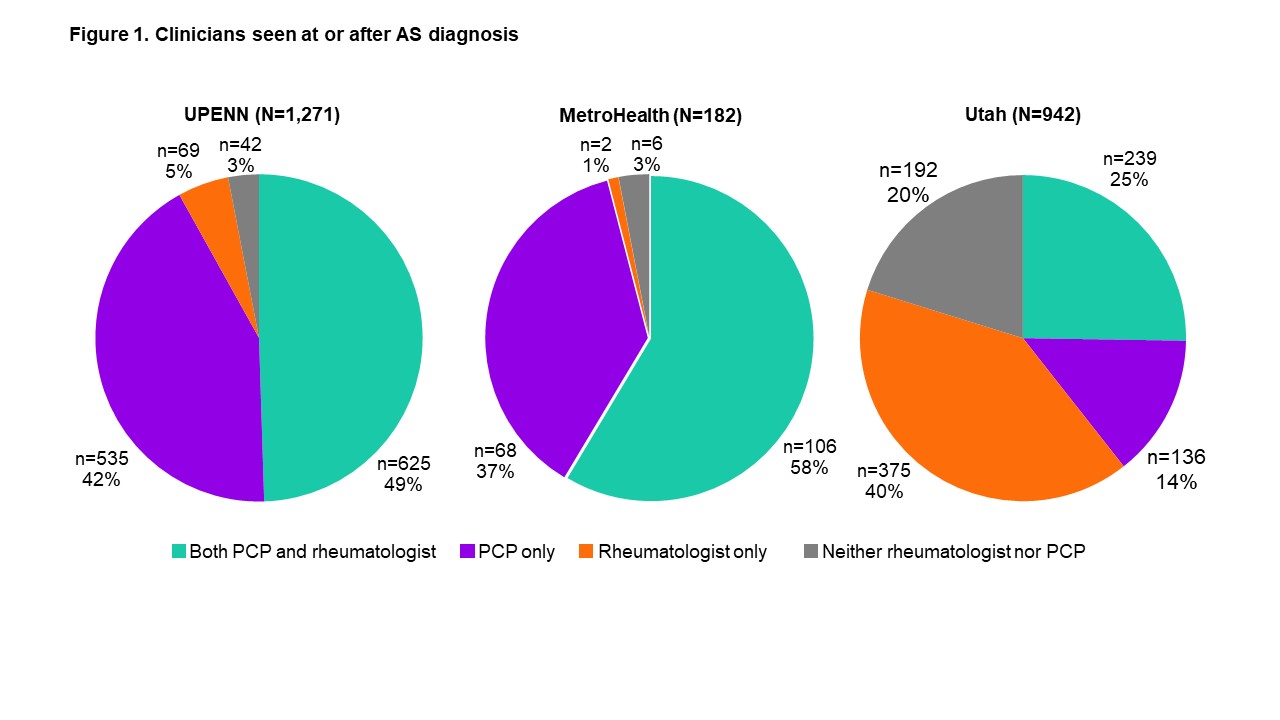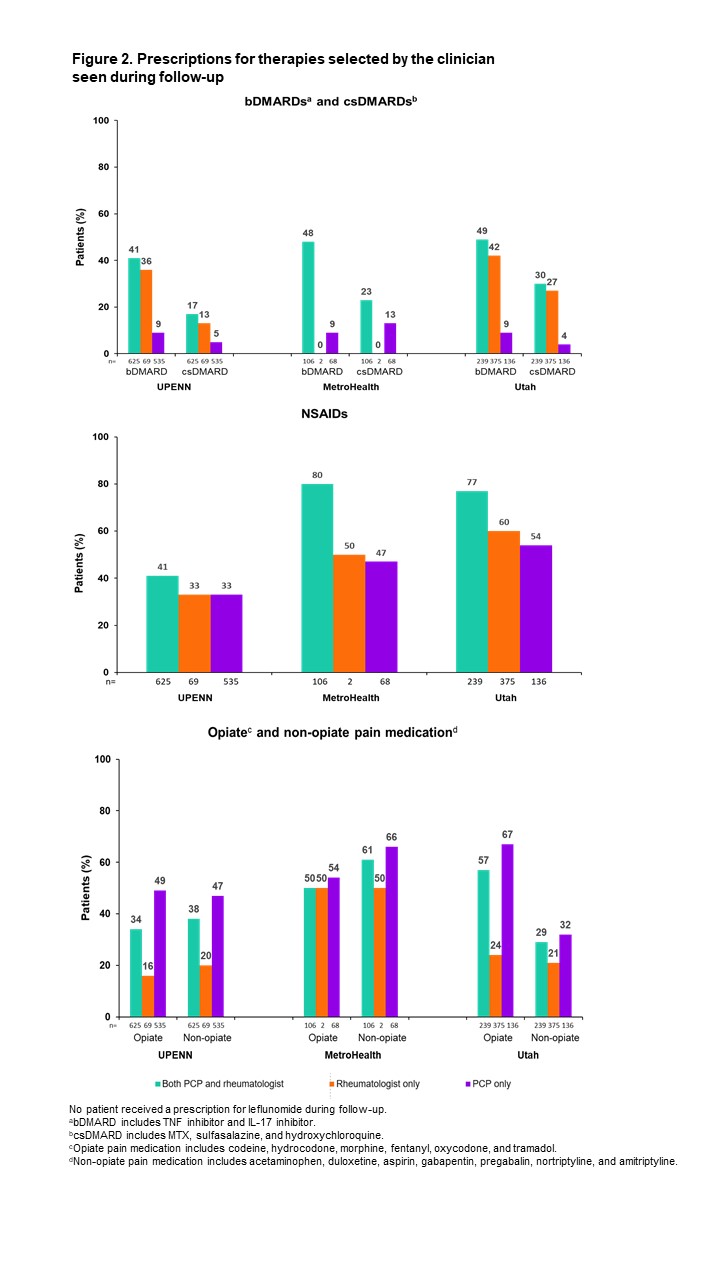Back
Poster Session A
Epidemiology, health policy and outcomes
Session: (0056–0084) Health Services Research Poster I: Lupus, RA, Spondyloarthritis and More
0078: Treatment of Ankylosing Spondylitis by Primary Care Physicians and Rheumatologists: A Retrospective Study in Three Health Systems
Saturday, November 12, 2022
1:00 PM – 3:00 PM Eastern Time
Location: Virtual Poster Hall
.png)
Alexis Ogdie, MD
Rheumatologist, Associate Professor of Medicine
University of Pennsylvania
Philadelphia, PA, United States
Abstract Poster Presenter(s)
Alexis Ogdie1, Marina Magrey2, Robert Fitzsimmons3, Shahrzad Abdollahi4, Wai Chung Yong5, Yasir Tarabichi6, Ana Biljan7, Christopher D. Saffore7, Kristin Tacelosky7 and Jessica Walsh8, 1Department of Medicine, Perelman School of Medicine at the University of Pennsylvania, Philadelphia, PA, 2Case Western Reserve University, University Hospitals, Richfield, OH, 3Department of Dermatology, Perelman School of Medicine, University of Pennsylvania, Philadelphia, PA, 4Division of Rheumatology, Lewis Katz School of Medicine, Temple University Hospital, Philadelphia, PA, 5Division of Rheumatology, The MetroHealth System Campus of Case Western Reserve University, Cleveland, OH, 6Department of Clinical Informatics Research and Education, The MetroHealth System Campus of Case Western Reserve University, Cleveland, OH, 7AbbVie, Inc., North Chicago, IL, 8University of Utah, Salt Lake City, UT
Background/Purpose: Most patients with undiagnosed ankylosing spondylitis (AS) seek care for back pain from primary care providers (PCPs), and treatment strategies adopted by PCPs may vary from those used by rheumatologists.1 The objective of this analysis was to examine the prescribing habits of rheumatologists and PCPs who were treating patients with AS.
Methods: A retrospective cross-sectional study was performed using electronic medical records from the health systems of the University of Pennsylvania (UPENN), the University of Utah (Utah), and from MetroHealth. Patients who were diagnosed with AS (International Classification of Diseases, 10th Revision code M45.X or M08.1) between January 2017 and September 2020 were included. Baseline characteristics at the time of first diagnosis code, visits to rheumatologists and PCPs, and prescribed therapies are reported descriptively.
Results: In total, 2,395 patients with a qualifying diagnosis code were identified: UPENN, n=1,271; MetroHealth, n=182; Utah, n=942. The mean age of patients was 51 years in UPENN and MetroHealth systems, and 44 years in the Utah system; 55%, 48%, and 48% of patients in the UPENN, MetroHealth and Utah systems, respectively, were male (Table 1). Common comorbidities included anemia, anxiety, depression, hyperlipidemia, and hypertension, although prevalence differed by health system. In contrast, the prevalence of inflammatory bowel disease, uveitis, and psoriasis were generally consistent across the three health systems. The proportions of patients who were seen by a rheumatologist, a PCP, or both, also differed by health system (Figure 1). Across all institutions, patients followed by a rheumatologist were far more likely to receive biologic DMARD (bDMARD) prescriptions than those followed by a PCP alone (Figure 2). Overall, conventional synthetic DMARDs (csDMARDs) were prescribed less frequently than bDMARDs and were not commonly prescribed to patients who were followed up by PCPs alone. Both opiate and non-opiate pain medications were commonly used and were most frequently prescribed to patients, followed up by PCPs alone.
Conclusion: In this population of patients with AS followed in three different health systems, bDMARDs and csDMARDs were more frequently prescribed to patients seen by a rheumatologist than to patients seen by a PCP alone. By contrast, opiate and non-opiate pain medications were prescribed more frequently to patients who were followed up by a PCP alone. These findings from multiple institutions demonstrate the variability in prescribing patterns between PCPs and rheumatologists and highlight areas for targeted education of clinicians caring for patients with AS.
Reference 1.Deodhar A, et al. Clin Rheumatol 2016;35:1769–76
.jpg)


Disclosures: A. Ogdie, AbbVie, Amgen, Novartis, Pfizer Inc, Bristol-Myers Squibb, Celgene, Janssen, CorEvitas, Gilead Sciences, Eli Lilly, GlaxoSmithKline, Happify Health, UCB; M. Magrey, AbbVie, Eli Lilly, Novartis, Pfizer Inc, UCB; R. Fitzsimmons, None; S. Abdollahi, None; W. Yong, None; Y. Tarabichi, None; A. Biljan, AbbVie; C. Saffore, AbbVie; K. Tacelosky, AbbVie; J. Walsh, AbbVie, Amgen, Lilly, Novartis, Pfizer, UCB, Celgene, Janssen, Merck.
Background/Purpose: Most patients with undiagnosed ankylosing spondylitis (AS) seek care for back pain from primary care providers (PCPs), and treatment strategies adopted by PCPs may vary from those used by rheumatologists.1 The objective of this analysis was to examine the prescribing habits of rheumatologists and PCPs who were treating patients with AS.
Methods: A retrospective cross-sectional study was performed using electronic medical records from the health systems of the University of Pennsylvania (UPENN), the University of Utah (Utah), and from MetroHealth. Patients who were diagnosed with AS (International Classification of Diseases, 10th Revision code M45.X or M08.1) between January 2017 and September 2020 were included. Baseline characteristics at the time of first diagnosis code, visits to rheumatologists and PCPs, and prescribed therapies are reported descriptively.
Results: In total, 2,395 patients with a qualifying diagnosis code were identified: UPENN, n=1,271; MetroHealth, n=182; Utah, n=942. The mean age of patients was 51 years in UPENN and MetroHealth systems, and 44 years in the Utah system; 55%, 48%, and 48% of patients in the UPENN, MetroHealth and Utah systems, respectively, were male (Table 1). Common comorbidities included anemia, anxiety, depression, hyperlipidemia, and hypertension, although prevalence differed by health system. In contrast, the prevalence of inflammatory bowel disease, uveitis, and psoriasis were generally consistent across the three health systems. The proportions of patients who were seen by a rheumatologist, a PCP, or both, also differed by health system (Figure 1). Across all institutions, patients followed by a rheumatologist were far more likely to receive biologic DMARD (bDMARD) prescriptions than those followed by a PCP alone (Figure 2). Overall, conventional synthetic DMARDs (csDMARDs) were prescribed less frequently than bDMARDs and were not commonly prescribed to patients who were followed up by PCPs alone. Both opiate and non-opiate pain medications were commonly used and were most frequently prescribed to patients, followed up by PCPs alone.
Conclusion: In this population of patients with AS followed in three different health systems, bDMARDs and csDMARDs were more frequently prescribed to patients seen by a rheumatologist than to patients seen by a PCP alone. By contrast, opiate and non-opiate pain medications were prescribed more frequently to patients who were followed up by a PCP alone. These findings from multiple institutions demonstrate the variability in prescribing patterns between PCPs and rheumatologists and highlight areas for targeted education of clinicians caring for patients with AS.
Reference 1.Deodhar A, et al. Clin Rheumatol 2016;35:1769–76
.jpg)


Disclosures: A. Ogdie, AbbVie, Amgen, Novartis, Pfizer Inc, Bristol-Myers Squibb, Celgene, Janssen, CorEvitas, Gilead Sciences, Eli Lilly, GlaxoSmithKline, Happify Health, UCB; M. Magrey, AbbVie, Eli Lilly, Novartis, Pfizer Inc, UCB; R. Fitzsimmons, None; S. Abdollahi, None; W. Yong, None; Y. Tarabichi, None; A. Biljan, AbbVie; C. Saffore, AbbVie; K. Tacelosky, AbbVie; J. Walsh, AbbVie, Amgen, Lilly, Novartis, Pfizer, UCB, Celgene, Janssen, Merck.

